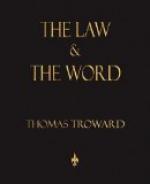Modern science thus shows us all material substance, whether that of inanimate matter or that of our own bodies, as proceeding out of one primary etheric substance occupying all space and homogeneous, that is being of a uniform substance—and having no qualities to distinguish one part from another. Now this conclusion of science is important because it is precisely the fact that out of this homogeneous substance particles are produced which differ from the original substance in that they possess positive and negative energy and of these particles the atom is built up. So then comes the question: What started this differentiation?
The electronic theory which I have just mentioned takes us as far as a universal homogeneous ether as the source from which all matter is evolved, but it does not account for how motion originated in it; but perhaps another closely allied scientific theory will help us. Let us, then, turn to the question of Vibrations or Waves in Ether. In scientific language the length of a wave is the distance from the crest of one wave to that of the wave immediately following it. Now modern science recognizes a long series of waves in ether, commencing with the smallest yet known measuring 0.1 micron, or about 1/254,000 of an inch, in length, measured by Professor Schumann in 1893, and extending to waves of many miles in length used in wireless telegraphy—for instance those employed between Clifden in Galway and Glace Bay in Nova Scotia are estimated to have a length of nearly four miles. These infinitesimally small ultra-violet or actinic waves, as they are called, are the principal agents in photography, and the great waves of wireless telegraphy are able to carry a force across the Atlantic which can sensibly affect the apparatus on the other side; therefore we see that the ether of space affords a medium through which energy can be transmitted by means of vibrations.
But what starts the vibrations? Hertz announced his discovery of the electro-magnetic waves, now known by his name, in 1888; but, following up the labours of various other investigators, Lodge, Marconi and others finally developed their practical application after Hertz’s death which occurred in 1894. To Hertz, however, belongs the honour of discovering how to generate these waves by means of sudden, sharply defined, electrical discharges. The principle may be illustrated by dropping a stone in smooth water. The sudden impact sets up a series of ripples all round the centre of disturbance, and the electrical impulse acts similarly in the ether. Indeed the fact that the waves flow in all directions from the central impulse is one of the difficulties of wireless telegraphy, because the message may be picked up in any direction by a receiver tuned to the same rate of vibration, and the interest for us consists in the hypothesis that thought-waves act in an analogous manner.




